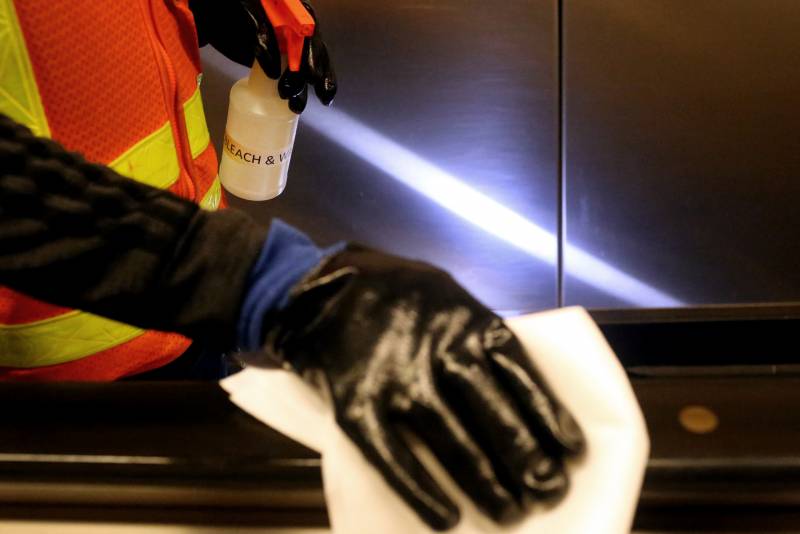Editors Note: This post has been edited to reflect the correct order of how long it takes for the new coronavirus to degrade on different types of surfaces, and to add details about cleaning solutions.
In an attempt to slow the spread of the novel coronavirus, California has ordered all residents to stay at home except to complete essential tasks like receiving medical care or obtaining groceries.
Yet, even inside, there is still potential for transmission. KQED’s Brian Watt spoke on Thursday with Sharon Begley, senior science writer with STAT, a health and medical science news website, about the ways people can prevent becoming infected. The following extracts from their conversation have been edited for length and clarity.
How long can the virus live on different surfaces?
If you touch a surface with the virus on it, it can be infectious. Researchers [in a study published in the New England Journal of Medicine] put the novel coronavirus on four different surfaces: copper, cardboard, stainless steel and plastic. And then they let the experiment run for 80 hours and measured every few hours to see how much virus remained on each surface. Long story short, the amount of virus plummeted most quickly on copper, then cardboard, then stainless steel. And the virus took the longest to reach undetectable levels on plastic.
What should we be cleaning surfaces in our home with? Bleach, alcohol?
Bleach absolutely works. Don’t use Clorox right out of the bottle. Instead, take four teaspoons and put it in a quart of water, or follow the manufacturer’s instructions for diluting it. You can use a diluted bleach solution for 24 hours, then you need to make a new solution.
Alcohol for cleaning a surface is fine. Check the label of the cleaner. Be sure it contains at least 70% alcohol. There’s a long list of other registered household disinfectants at the CDC’s website. Each disinfectant has to be left wet on the counter or other surface for a different amount of time before wiping.
When you clean, don’t use a sponge, because you’ll have to throw it away afterwards. Use disposable paper towels or something like that.
Of course, if you disinfect a surface that you use for food, you’ll also want to wipe it down with water, afterword. Contrary to President Trump’s ill-fated musings on national television, bleach does not belong in your body.
How often should we be cleaning?
If you have just brought in the mail, if you have brought in a package that’s been left on your front stoop, if you have brought in anything from the outside world and put it on your kitchen counter or your table or even the floor, just consider that surface something that needs to be wiped down.
If you’ve wiped that surface down at 8 p.m., say, and you’re in for the night, and nothing else from the outside world comes in, you are fine. You’re not going to need to wipe it down at 8 a.m. the next morning or even at noon. You don’t have to be compulsive about swabbing every few hours. The coronavirus is not coming in through your window.
What about when you wash your hands?
For your hands, plain old soap is best. If you want to use alcohol disinfectant, hand sanitizer, that’s okay if you’re out in the world and you can’t get to a sink and use soap. The reason to use soap is that it has molecular properties that destroy the virus. And the virtue of washing your hands with soap under running water at a sink is that the running water takes anything that comes off your hands and sends it down the drain.
When should you wash your hands?
We usually touch things without thinking about it. You know, you come in from outside and you’ve picked up the mail or something. As soon as you touch something from and certainly when you come in from outside, wash your hands.
Can the coronavirus live in a room after an infected person leaves that room?
There’s a distinction between aerosol transmission, when something stays in the air for a long time, and airborne, which means it just travels through the air. Airborne is like a fly ball to center field: It’s in the air for a while, but it comes down really fast. Aerosol is like fog; all those little particles of water stay in the air for hours, if not days.
The coronavirus can be airborne. It can fly from one person’s mouth onto a surface or onto another person. But it cannot hang in the air. So if you are worried about being in an elevator where maybe someone who is infected has been, simply breathing the air is not going to be contagious.
Whether people are coughing, sneezing or even talking, the virus cannot travel more than 6 feet. It has weight, and there’s this thing called gravity. It falls, so it’s not going to reach you.

